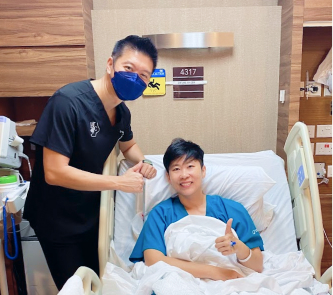Ankle Sprain: Causes And Treatment
What Is An Ankle Sprain?
An ankle sprain is a common injury that occurs when the ligaments supporting the ankle bones become overly stretched or torn. This happens when a sudden rolling or twisting motion of the foot causes the joint to be displaced – usually as a result of a fall or a sports injury.
Depending on the severity of the ankle cartilage injury, the ankle sprain treatment will vary. For mild sprains, sufficient rest and at-home care may suffice. However, ankle sprains are best assessed by a medical professional to ensure that appropriate treatment is given and no underlying injuries are left undetected.

What Are The Causes
Of Ankle Sprains?
- Walking or stepping on an uneven surface
- Falling on the ankle
- Landing awkwardly after jumping
- Suddenly turning or pivoting
- Another person stepping on one’s foot while one is running
- Wearing inappropriate footwear

What Are the Risk Factors for Ankle Sprains?
Some factors that can increase the risk of ankle sprain include:
- Physical Activity - Sports that involve running, jumping or quick directional changes—such as basketball, football or tennis—can put stress on the ankle.
- Uneven Surfaces - Walking or exercising on uneven ground—such as trails, fields or poorly maintained pavements—can increase the likelihood of twisting an ankle.
- Previous Injuries - Individuals with a history of ankle injuries are more susceptible to future sprains, as previous damage can weaken the ligaments.
- Inappropriate Footwear - Shoes lacking proper support or traction, such as high-heeled shoes or worn-out trainers, can destabilise the ankle.
- Poor Physical Condition - Weak ankle muscles, limited flexibility or poor balance can reduce stability, increasing the chance of a sprain.
- Anatomical Factors - Certain foot structures—such as high arches or flat feet—may lead to ankle instability.
How Is an Ankle Sprain Diagnosed?
To diagnose an ankle sprain, your doctor will ask how the injury happened, review your symptoms, and examine the ankle for swelling, tenderness, movement and stability. Beyond this physical exam, the doctor may order imaging tests to determine the extent of the injury:
- X-ray - These are often used to rule out broken bones. While they do not show soft tissues, they can help detect bone injuries.
- MRI - Provides detailed images of soft tissues, including ligaments and tendons, and is the preferred test for assessing sprains.
What Are The Treatments for Ankle Sprains?
Apart from a physical examination, the ankle surgeon in Singapore will arrange for imaging tests such as an X-ray, CT scan or MRI to determine the details and extent of the injury.
Treatment for ankle sprains will depend on the severity of the injury, and will always start from the most conservative option possible first. Options include:
Self-Care Remedies
For mild cases, home treatments are recommended to facilitate the sprain’s natural healing. The most common way to address sprains at home is through the RICE method:
- Rest – To prevent worsening the sprain, it is best to rest the ankle by avoiding physically strenuous activities and protecting the area using a brace or splint.
- Ice – Applying an ice pack or cold compress on the ankle for 15 to 20 minutes every 2 to 3 hours helps reduce redness and swelling.
- Compression – Wrapping the ankle with an elastic bandage or wearing compression sleeves can help reduce swelling and promote better blood flow for healing.
- Elevation – Elevating the ankle above the level of the heart can also reduce swelling and drain excess fluid.
Medications, Physiotherapy and Mobility Aids
Ankle Surgery
For severe cases where the sprained ankle is not responding to conservative treatments, or the damage is deemed serious, surgery may be advised. Surgical treatments usually involve:
- Arthroscopy, which is a keyhole procedure that involves assessing the ankle joint with a tiny lens, removing inflamed or damaged tissue, while also treating cartilage injury at the same time.
- Reconstruction, which involves either repairing the torn ligament, or using ligaments from other parts of the body to repair or replace the damaged ankle ligament. At The Bone & Joint Centre (BJC), we do our ligament repair via an innovative breakthrough “keyhole” method (ArthroBrostrum repair) which is less painful, has fewer wound complications and leads to quicker recovery compared to the open traditional method.
If you have sustained an ankle injury, consult an orthopaedic specialist for a detailed assessment so that the most appropriate and effective treatment can be tailored for you.
Can Ankle Sprains Be Prevented?
While not all ankle sprains can be avoided, incorporating these measures into daily routines or sports activities can significantly lower the risk:
- Strength and Balance Training – Exercises like calf raises, ankle circles or balance drills can strengthen the muscles around the ankle, improving stability.
- Proper Footwear – Wear shoes suited for the activity or sport, with adequate arch support and traction.
- Warm-Up and Stretching – Before physical activity, warm up and stretch to prepare the muscles and improve flexibility.
- Surface Awareness – Be mindful of the environment and avoid activities on uneven or slippery surfaces.
- Bracing or Taping – For those with a history of sprains, ankle braces or taping can provide additional support during high-risk activities and prevent re-injury.
Frequently Asked Questions
Can ankle sprains heal on their own?
Mild ankle sprains typically heal on their own with proper self-care, such as the RICE method, while severe sprains may require medical intervention and physiotherapy for complete healing.
When should I see a doctor for a suspected ankle sprain?
Consult a doctor if there is intense pain, significant swelling, inability to bear weight or a deformity in the ankle. Additionally, seek medical attention if symptoms do not improve after a few days of self-care or if you suspect a fracture or serious ligament damage.
Can I still walk on a sprained ankle?
Whether you can walk on a sprained ankle depends on the injury's severity. With a mild sprain, you might be able to walk a little with proper support. However, for moderate to severe sprains, walking too soon can worsen the injury and delay healing. It is best to use crutches or a brace and avoid putting weight on the ankle until it is stable.
How long does it take to heal an ankle sprain?
Healing time varies by sprain severity:
- For Grade 1 – One to two weeks with proper rest and care
- For Grade 2 – Three to six weeks, often requiring physiotherapy
- For Grade 3 – 12 weeks or longer, potentially needing immobilisation or surgery in rare cases
What happens if ankle sprains are left untreated?
If an ankle sprain is not properly managed, it may heal more slowly or lead to ongoing issues such as stiffness, occasional pain or a higher chance of re-injury. In more severe or repeated cases, long-term instability may develop. Early treatment and rehabilitation help ensure a full recovery and reduce these risks.
Useful Links:
- Read Dr Kevin Koo’s SingHealth Article, “Treat Ankle Sprains Promptly”: https://www.singhealth.com.sg/news/patient-care/treat-ankle-sprains-promptly
Our Ankle Surgeon in Singapore
FRCSEd (Orth), FAMS
Dr Kevin Koo is an experienced ankle surgeon with over 20 years of experience treating ankle sprains. Dr Koo completed a fellowship at St. Mary's and Charing Cross Hospitals, Imperial College Healthcare in London, UK, where he worked with internationally recognised orthopaedic surgeons and treated professional athletes and dancers.
Dr Koo's dedication to the field is evident in his numerous accolades and his former role as Director of Foot and Ankle Service at Singapore General Hospital. He also actively contributes to advancements in foot and ankle surgery through his published research in numerous peer-reviewed medical journals.



| Tel. | : +65 6970 5905 |
| Fax | : +65 6970 5906 |
| Mobile | : +65 9898 7781 |
| : hello@bjc.sg , drkevinkoo@bjc.sg |
| Mon - FriMonday to Friday | :8:30am to 5:30pm |
| Sat, Sun and PHSaturday, Sunday & PH | :Closed |
Well-being: Our Focus at
The Bone & Joint Centre.
get in touch as soon as possible.
| Tel. | : +65 6970 5905 |
| Fax | : +65 6970 5906 |
| Mobile | : +65 9898 7781 |
| : hello@bjc.sg , drkevinkoo@bjc.sg |
| Mon - FriMonday to Friday | :8:30am to 5:30pm |
| Sat, Sun and PHSaturday, Sunday & PH | :Closed |





